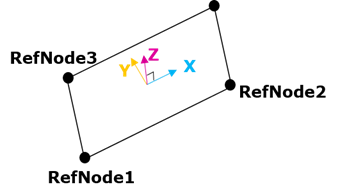
The GET_RFLEX_NSTRAIN_3NREF subroutine returns the nodal strain. GET_RFLEX_ NSTRAIN_3NREF is an auxiliary subroutine for MODAL_FORCE or MODAL_FORCE_EXT.
The difference between GET_RFLEX_NSTRAIN and GET_RFLEX_NSTRAIN_3NREF is the definition of output reference frame. The output reference frame of GET_RFLEX_NSTRAIN subroutine uses a marker. The output reference frame of GET_RFLEX_NSTRAIN_3NREF is defined 3 refernce nodes like Fig 1.
|
Langunage type |
SubRoutine |
|
FORTRAN |
call get_rflex_nstrain_3nref(ifbody, NodeSqeId, fTopBot, refnode1, refnode2, refnode3, strain, errflg) |
|
C/C++ |
get_rflex_nstrain_3nref(ifbody, NodeSeqId, fTopBot, refnode1, refnode2, refnode3, strain, &errflg)) |

Figure 1 Definition of 3 nodal point reference frame
Parameter information
|
Variable Name |
Size |
Description |
|
ifbody |
int |
Sequential id of RFlex body defined in RecurDyn/Solver. |
|
NodeSeqId |
int |
Node sequential id defined in RecurDyn/Solver. A node id should be converted to the node sequential id using the Get_rflex_nodeseqid auxiliary function. |
|
fTopBot |
int |
If the RFI file has shell type element and all surface types (Top and Bottom) of the strain shapes, then this argument is reffered. 1: Top, 2: Bottom |
|
refnode1 |
int |
1st Reference Node Seq. ID |
|
refnode2 |
int |
2nd Reference Node Seq. ID |
|
refnode3 |
int |
3rd Reference Node Seq. ID |
|
strain |
double[11] |
1~6th data : Strain tensor (Exx,Eyy,Ezz,Exy,Eyz,Ezx) 7~9th data : Principal strain 10th data : Intensity strain 11th data : Von-mises strain |
|
Errflg |
int |
Error flag. If the result of this argument is -1 (means TRUE in Fortran logical value), there’s no error. The others means there’s an error. |